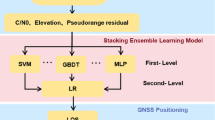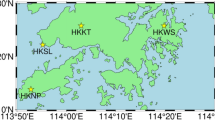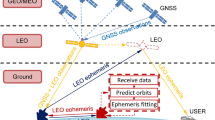Abstract
GNSS/INS integrated navigation system is particularly outstanding in providing reliable navigation information for land vehicle applications. However, GNSS measurements are easily disturbed in harsh operating environments, especially the accuracy of integrated navigation system integrated with inertial navigation system will be affected accordingly. Hence, a robust adaptive extended Kalman filter procedure is crucial to maintain the stability and reliability of the system. In this study, a robust factor based on local test of standardized residual vector was proposed to deal with potential gross errors, and an adaptive factor based on position dilution of precision which reflect the satellite geometry was proposed to adjust covariance matrix. The robust adaptive factor function models are established to adjust the dynamic model and abnormal measurements. The test results show that the standard extended Kalman filter cannot always give an optimal solution due to the influence of GNSS measurements and satellite geometry especially in the complex environment, while the proposed method improves the reliability of the integrated navigation system by adopting robust adaptive factor.
Similar content being viewed by others
Abbreviations
- δr n :
-
error vectors of position (m)
- δv n :
-
error vectors of velocity (m/s)
- ψ n :
-
error vectors of attitude (rad/s)
- ∇ :
-
accelerometer error vector (m/s2)
- f n :
-
vectors of specific force (N)
- ε:
-
gyro drift (rad/s)
- ω n ie :
-
earth rotation velocity in the n-frame (rad/s)
- ω n en :
-
the rotation vector from the e-frame to the n-frame (rad/s)
- ω n in :
-
the sum of the ω nie and ω nen (rad/s)
- \(d{t_{{u_b}}}\) :
-
receiver clock bias (m)
- \(d{t_{{u_d}}}\) :
-
receiver clock drift (m)
- ρ I :
-
pseudo range measurements from INS (m)
- ω G :
-
pseudo range measurements from GPS (m)
- ω̇ I :
-
pseudo range rate measurements from INS (m/s)
- ω̇ G :
-
pseudo range rate measurements from GPS (m/s)
- INS:
-
inertial navigation system
- GNSS:
-
global navigation satellite system
- SGEs:
-
slowly growing errors
- FDI:
-
fault detection and isolation
- KF:
-
kalman filter
- AIME:
-
autonomous integrity monitoring by extrapolation
- MMAE:
-
multiple-model-based adaptive estimation
- EKF:
-
extended kalman filter
- IAE:
-
innovation-based adaptive estimation
- RAE:
-
residual-based adaptive estimation
- PDOP:
-
position dilution of precision
- RAIM:
-
autonomous integrity monitoring
- IMU:
-
inertial measurement unit
References
Alfakih, M., Keche, M. and Benoudnine H. (2018). A new Wi-Fi/GPS fusion method for robust positioning in urban environments. Physical Communication, 31, 10–20.
Almagbile A. (2019). Geometric and statistical interpretation of correlation between fault tests in integrated GPS/INS systems. J. Applied Geodesy 13, 3, 267–278.
Amato, F., Cosentino, C., Mattei, M. and Paviglianiti, G. (2006). A direct/functional redundancy scheme for fault detection and isolation on an aircraft. Aerospace Science and Technology, 10, 338–345.
Angrisano, A., Maratea, A. and Gaglione, S. (2018). A resampling strategy based on bootstrap to reduce the effect of large blunders in GPS absolute positioning. J. Geodesy, 92, 81–92.
Bhatti, U. and Ochieng, W. (2009). Detecting multiple failures in GPS/INS integrated system: A novel architecture for integrity monitoring. J. Global Positioning Systems 8, 1, 26–12.
Bhatti, U., Ochieng, W. and Feng, S. (2007a). Integrity of an integrated GPS/INS system in the presence of slowly growing errors. Part I: A critical review. GPS Solutions, 11, 173–181.
Bhatti, U., Ochieng, W. and Feng, S. (2007b). Integrity of an integrated GPS/INS system in the presence of slowly growing errors. Part II: analysis. GPS Solutions, 11, 183–192.
Chen, J., Zhang, S., Cao, Y., Li, H. and Zheng, H. (2020). A robust fault detection algorithm for the GNSS/INS integrated navigation systems. J. Geodesy and Geoinformation Science 3, 1, 12–24.
Chiang, K. W., Tsai, G. J., Li, Y. and El-Sheimy, N. (2020). Navigation engine design for automated driving using INS/GNSS/3D LiDAR-SLAM and integrity assessment. Remote Sensing 12, 10, 1564.
Choi, S. and Hong, D. (2021). Position estimation in urban u-turn section for autonomous vehicles using multiple vehicle model and interacting multiple model filter. Int. J. Automotive Technology 22, 6, 1599–1607.
Doostdar, P., Keighobadi, J. and Hamed, M. A. (2020). ING/GNSS integration using recurrent fuzzy wavelet neural networks. GPS Solutions, 24, 29.
Gullu, M. and Yilmaz, I. (2010). Outlier detection for geodetic nets using ADALINE learning algorithm. Scientific Research & Essays 5, 5, 440–447.
Han, H. and Wang, J. (2017). Robust GPS/BDS/INS tightly coupled integration with atmospheric constraints for long-range kinematic positioning. GPS Solutions, 21, 1285–1299.
Hewitson, S. and Wang, J. (2006). GNSS receiver autonomous integrity monitoring (RAIM) performance analysis. GPS Solutions, 10, 155–170.
Hewitson, S. and Wang, J. (2010). Extended receiver autonomous integrity monitoring (eRAIM) for GNSS/INS Integration. J. Surveying Engineering, 136, 13–22.
Hwang, Y., Jeong, Y., Kweon, I. S. and Choi, S. (2021). Online misalignment estimation of strapdown navigation for land vehicle under dynamic condition. Int. J. Automotive Technology 22, 6, 1723–1733.
Jiang, H., Shi, C., Li, T. and Jing, G. (2021). Low-cost GPS/INS integration with accurate measurement modeling using an extended state observer. GPS Solutions, 25, 17.
Katriniok, A. and Abel, D. (2016). Adaptive EKF-based vehicle state estimation with online assessment of local observability. IEEE Trans. Control Systems Technology 24, 4, 1368–1381.
Knight, N. L. and Wang, J. (2009). A comparison of outlier detection procedures and robust estimation methods in GPS positioning. J. Navigation 62, 4, 699–709.
Kottath, R., Narkhede, P, Kumar, V., Karar, V. and Poddar, S. (2017). Multiple model adaptive complementary filter for attitude estimation. Aerospace Science and Technology, 69, 574–581.
Lee, J. Y., Kim, H. S., Choi, K. H., Lim, J., Chun, S. and Lee, H. K. (2016). Adaptive GPS/INS integration for relative navigation. GPS Solutions 20, 1, 63–75.
Lee, J., Shin, H. and Kim, T. (2018). Optimal combination of fault detection and isolation methods of integrated navigation algorithm for UAV. Int. J. Aeronautical and Space Sciences, 19, 694–710.
Li, X., Wang, X., Liao, J., Li, X. and Lyu, H. (2021). Semi-tightly coupled integration of multi-GNSS PPP and S-VINS for precise positioning in GNSS-challenged environments. Satellite Navigation 2, 1, 1–14.
Lim, J. H., Choi, K. H., Cho, J. and Lee, H. K. (2017). Integration of GPS and monocular vision for land vehicle navigation in urban area. Int. J. Automotive Technology 18, 2, 345–356.
Miao, L. and Shi, J. (2014). Model-based robust estimation and fault detection for MEMS-INS/GPS integrated navigation systems. Chinese J. Aeronautics 27, 4, 947–954.
Park, C. H. and Kim, N. H. (2014). Precise and reliable positioning based on the integration of navigation satellite system and vision system. Int. J. Automotive Technology 15, 1, 79–87.
Roysdon, P. F. and Farrell, J. A. (2017). Robust GPS-INS outlier accommodation: A soft-thresholded optimal estimator. IFAC-PapersOnLine 50, 1, 3574–3579.
Shen, C., Zhang, Y., Guo, X., Chen, X. and Liu, J. (2020). Seamless GPS/inertial navigation system based on self-learning square-root cubature Kalman filter. IEEE Trans. Industrial Electronics 68, 1, 499–508.
Srilatha, V., Dutt, I., Sasi, G., Swapna, S., Swarna, R., Rajkumar, G. and Usha, C. (2009). Investigation of GDOP for precise user position computation with all satellites in view and optimum four satellite configurations. The J. Indian Geophysical Union 13, 3, 139–148.
Trigo, G. F., Theil, S., Vandersteen, J., Bennani, S. and Roux, C. (2019). Robust tightly coupled hybrid navigation for space transportation. J. Spacecraft and Rockets 56, 2, 596–609.
Yang, L. and Shen, Y. (2020). Robust M estimation for 3D correlated vector observations based on modified bifactor weight reduction model. J. Geodesy, 94, 31.
Yang, L., Nie, Y. and Shen, Y. (2019). Characteristic analysis of 3D outlier detection method for GNSS network adjustments. J. Surveying Engineering 145, 4, 04019014.
Yang, Y. and Gao, W. (2006). An optimal adaptive Kalman filter. J. Geodesy 80, 4, 177–183.
Yang, Y., He, H. and Xu, G. (2001). Adaptively robust filtering for kinematic geodetic positioning. J. Geodesy 75, 2, 109–116.
Yoon, J. H., Eben, L. S. and Ahn, C. (2016). Estimation of vehicle sideslip angle and tire-road friction coefficient based on magnetometer with GPS. Int. J. Automotive Technology 17, 3, 427–435.
Yu, H., Han, H., Wang, J., Xiao, H. and Wang, C. (2020). Single-frequency GPS/BDS RTK and INS ambiguity resolution and positioning performance enhanced with positional polynomial fitting constraint. Remote Sensing 12, 15, 2374.
Zhang, Q., Zhao, L., Zhao, L. and Zhou, J. (2018). An improved robust adaptive Kalman filter for GNSS precise point positioning. IEEE Sensors J. 18, 10, 4176–4186.
Zhong, L., Liu, J., Li, R. and Wang, R. (2017). Approach for detecting soft faults in GPS/INS integrated navigation based on LS-SVM and AIME. J. Navigation 70, 3, 561–579.
Acknowledgement
This research was supported by the Natural Science Foundation of the Jiangsu Higher Education Institutions of China (Grant No. 19KJB510028), the National Natural Science Foundation of China (Grant No. 61803188) and the Doctoral Scientific Research Startup Foundation of Jinling Institute of Technology (Grant No. jit-b-201603) and Postdoctoral Foundation of Jiangsu Province (Grant No. 2021K463C).
Author information
Authors and Affiliations
Corresponding author
Additional information
Publisher’s Note
Springer Nature remains neutral with regard to jurisdictional claims in published maps and institutional affiliations.
Rights and permissions
About this article
Cite this article
Wu, Y., Chen, S. & Yin, T. GNSS/INS Tightly Coupled Navigation with Robust Adaptive Extended Kalman Filter. Int.J Automot. Technol. 23, 1639–1649 (2022). https://doi.org/10.1007/s12239-022-0142-7
Received:
Revised:
Accepted:
Published:
Issue Date:
DOI: https://doi.org/10.1007/s12239-022-0142-7




